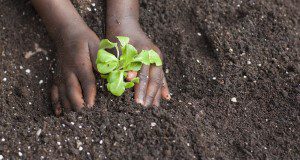Soils are a foundational component of the landscape, providing a medium for plant root growth and playing a crucial role in nutrient cycling and water movement across the landscape. This new 7-page article describes the physical properties of soils, including soil formation in Florida, the soil profile, and water dynamics within soils, and provides a thorough reference for Master Gardeners and other individuals searching for a basic understanding of soil dynamics to apply to residential landscapes. Written by Amy L. Shober, Alexander J. Reisinger, Mary G. Lusk, and Sally Ann Scalera and published by the UF/IFAS Department of Soil and Water Sciences.
https://edis.ifas.ufl.edu/mg458
Tag: Amy L. Shober
Incorporating Woody Ornamentals into Residential Landscapes to Reduce Nutrient Leaching
 Urban landscapes in Florida are typically dominated by turfgrass monoculture, with ornamental landscape plants comprising only a small portion of the landscape. Incorporating more woody ornamentals into your landscape can reduce fertilization and irrigation demand and help reduce nutrient leaching losses from your yard—a combination that will help protect Florida’s water resources. This 3-page fact sheet was written by Drew C. McLean, Andrew K. Koeser, Amy L Shober, Zhixuan Qin, Gitta Hasing, and Richard C. Beeson, and published by the UF Department of Environmental Horticulture, July 2014.
Urban landscapes in Florida are typically dominated by turfgrass monoculture, with ornamental landscape plants comprising only a small portion of the landscape. Incorporating more woody ornamentals into your landscape can reduce fertilization and irrigation demand and help reduce nutrient leaching losses from your yard—a combination that will help protect Florida’s water resources. This 3-page fact sheet was written by Drew C. McLean, Andrew K. Koeser, Amy L Shober, Zhixuan Qin, Gitta Hasing, and Richard C. Beeson, and published by the UF Department of Environmental Horticulture, July 2014.
http://edis.ifas.ufl.edu/ep503
Engaging Youth in the Environment through the Florida Land Judging Program (SL362/SS563)
 The Florida 4-H/FFA Land Judging Contest is steeped in a tradition of enthusiastic participation, challenging science, and dynamic field conditions. Learn more in this 3-page fact sheet written by Amy L. Shober, L. Rex Ellis, Edward A. Hanlon, and Christine Wiese, and published by the UF Department of Soil and Water Science, November 2011.
The Florida 4-H/FFA Land Judging Contest is steeped in a tradition of enthusiastic participation, challenging science, and dynamic field conditions. Learn more in this 3-page fact sheet written by Amy L. Shober, L. Rex Ellis, Edward A. Hanlon, and Christine Wiese, and published by the UF Department of Soil and Water Science, November 2011.
http://edis.ifas.ufl.edu/ss563
Rules and Scorecard Grading Policies for the Annual Florida 4-H/FFA Land Judging Contest (SL144/SS195)
 This 11-page fact sheet outlines the rules of the annual Florida 4-H/FFA Land Judging Contest and guides participants in correctly completing the Land Judging and Homesite Evaluation scorecards. Written by Amy L. Shober, L. Rex Ellis, Christine Wiese, Edward A. Hanlon, Randy B. Brown, and J.H. Herbert, Jr., and published by the UF Department of Soil and Water Science, November 2011.
This 11-page fact sheet outlines the rules of the annual Florida 4-H/FFA Land Judging Contest and guides participants in correctly completing the Land Judging and Homesite Evaluation scorecards. Written by Amy L. Shober, L. Rex Ellis, Christine Wiese, Edward A. Hanlon, Randy B. Brown, and J.H. Herbert, Jr., and published by the UF Department of Soil and Water Science, November 2011.
http://edis.ifas.ufl.edu/ss195
An Overview of Nutrient Budgets for Use in Nutrient Management Planning (SL361/SS562)
 For professionals responsible for ensuring water quality, this 4-page fact sheet describes the types and limitations of nutrient budgets. Written by Amy L. Shober, George Hochmuth, and Christine Wiese, and published by the UF Department of Soil and Water Science, November 2011.
For professionals responsible for ensuring water quality, this 4-page fact sheet describes the types and limitations of nutrient budgets. Written by Amy L. Shober, George Hochmuth, and Christine Wiese, and published by the UF Department of Soil and Water Science, November 2011.
http://edis.ifas.ufl.edu/ss562
Improving the Health of Declining Loropetalum in the Home Landscape (SL354/SS556)
 Loropetalum, or Chinese Witch Hazel, is a common landscape plant in north and central Florida. It’s relatively pest-free, but there have been increasing reports of decline — likely due to nutrient deficiencies in the soil. This 3-page fact sheet familiarizes homeowners with the symptoms of Loropetalum decline and provides options to improve the health of afflicted Loropetalum in the landscape. Written by Joe Sewards and Amy L. Shober and published by the UF Department of Soil and Water Science, August 2011.
Loropetalum, or Chinese Witch Hazel, is a common landscape plant in north and central Florida. It’s relatively pest-free, but there have been increasing reports of decline — likely due to nutrient deficiencies in the soil. This 3-page fact sheet familiarizes homeowners with the symptoms of Loropetalum decline and provides options to improve the health of afflicted Loropetalum in the landscape. Written by Joe Sewards and Amy L. Shober and published by the UF Department of Soil and Water Science, August 2011.
http://edis.ifas.ufl.edu/ss556
Soil pH and the Home Landscape or Garden (SL256/SS480)
Homeowners and gardeners alike are interested in soil pH because soil pH directly affects the growth and quality of many landscape plants by influencing the chemical form of many elements in the soil and soil microbial processes. This 3-page fact sheet explains soil pH and provides strategies for Master Gardeners and homeowners to make the most of the pH in the home landscape or garden. Written by Amy L. Shober, Christine Wiese, and Geoffrey C. Denny, and published by the UF Department of Soil and Water Science, May 2011.
http://edis.ifas.ufl.edu/ss480
SL322/SS534 Preplant Soil Assessment for New Residential Landscapes in Florida
SL322, a 5-page illustrated fact sheet by Amy L. Shober and Christine Wiese, advocates performing an assessment of soil conditions before landscape installation, and outlines the issues that may be identified through such an assessment. Includes references. Published by the UF Department of Soil and Water Science, June 2010.
http://edis.ifas.ufl.edu/ss534
SL 318/SS530 Identifying Nutrient Deficiencies in Ornamental Plants
SL318, a 4-page illustrated fact sheet by Amy L. Shober and Geoffrey C. Denny, provides guidance for the visual diagnosis of major nutrient deficiency symptoms in ornamental plants. Published by the UF Department of Soil and Water Science, March 2010.
http://edis.ifas.ufl.edu/ss530
SL312/SS524 Drinking Water Source Protection in the Tampa Bay Region: A Guide for Government Officials
SS524, a 4-page fact sheet by Amy L. Shober, familiarizes government officials in the Tampa Bay Region with some of the regulatory and non-regulatory tools that can help to protect local sources of drinking water. Includes references. Published by the UF Department of Soil and Water Science, December 2009.
http://edis.ifas.ufl.edu/SS524
ENH1130/EP391 Establishing Shrubs in Florida Landscapes
ENH-1130, a 6-page illustrated fact sheet by Edward F. Gilman, Amy L. Shober, Kimberly A. Moore, Christine Wiese, Maria Paz, and S. Michelle Scheiber, describes the steps that homeowners should take for effective irrigation of transplanted, container-grown shrubs in the home landscape until there is sufficient root growth for them to become established. Includes references. Published by the UF Department of Environmental Horticulture, June 2009.
http://edis.ifas.ufl.edu/EP391
ENH1129/EP390 Planting Shrubs in Florida Landscapes
ENH-1129, a 4-page illustrated fact sheet by Edward F. Gilman, Amy L. Shober, Kimberly A. Moore, Christine Wiese, Maria Paz and S. Michele Scheiber, provides guidance for planting shrubs in Florida home landscapes. Includes references. Published by the UF Department of Environmental Horticulture, June 2009.
http://edis.ifas.ufl.edu/EP390
ENH02/LH012 Preparing to Plant a Florida Lawn
Revised! ENH-02, a 4-page illustrated fact sheet by L.E. Trenholm and Amy L. Shober, provides a general guideline to the steps for preparing the soil before planting a lawn. Includes references. Published by the UF Department of Environmental Horticulture, May 2009.
http://edis.ifas.ufl.edu/LH012
SL281/SS494 Soil Sampling and testing for the Home Landscape or Vegetable Garden
SL-281, a 6-page illustrated fact sheet by Amy L. Shober, and Rao S. Mylavarapu, provides information for homeowners about taking a soil sample and submit it for testing and how to understand the soil test report. Published by the UF Department of Soil and Water Science, March 2009.
http://edis.ifas.ufl.edu/SS494
SL280/SS493 Drinking Water Source Protection in the Tampa Bay Region: A Guide for Homeowners
SL-280, a 3-page illustrated fact sheet by Amy L. Shober, familiarizes homeowners in the Tampa Bay region with the local sources of drinking water, potential pollution sources, and actions that can protect the quality of the local drinking water supply. Includes references. Published by the UF Department of Soil and Water Science, February 2009.
http://edis.ifas.ufl.edu/SS493
SL277/MG457 Soils and Fertilizers for Master Gardeners: Glossary of Soil and Fertilizer Terms
SL277, a 4-page illustrated fact sheet by Shawna Loper and Amy L. Shober, contains the definitions of important soil and fertilizer terms used throughout the Soils and Fertilizers for Master Gardeners EDIS series. Published by the UF Department of Soil and Water Science, December 2008.
http://edis.ifas.ufl.edu/MG457
SL276/MG456 Soils & Fertilizers for Master Gardeners: Urban Soils and their Management Issues
SL-276, a 3-page fact sheet by Amy L. Shober and Gurpal S. Toor, is part of the Florida Master Gardener Handbook. It describes the characteristics of urban soils and the associated management issues, specifically for soils in residential landscapes. Includes references. Published by the UF Soil and Water Science Department, December 2008.
http://edis.ifas.ufl.edu/MG456
SL273/MG454 Soils & Fertilizers for Master Gardeners: Soil Organic
SL-273, a 3-page illustrated fact sheet by Gurpal S. Toor and Amy L. Shober, educates homeowners about the importance of soil organic matter and provides suggestions about how to build the organic matter in garden and landscape soils. Includes references. Published by the UF Department of Soil and Water Science, November 2008.
http://edis.ifas.ufl.edu/MG454
SL274/MG455 Soils & Fertilizers for Master Gardeners: Soil Formation in Florida
SL274, a 4-page illustrated fact sheet by Amy L. Shober and Thomas Obreza, provides information about types of soils found in Florida and the factors that influenced their formation. Includes references. Published by the UF Department of Soil and Water Science, November 2008.
http://edis.ifas.ufl.edu/MG455
SL272/MG453 Soils & Fertilizers for Master Gardeners: Soil Drainage and Water Holding Capacity
SL-272, a 3-page illustrated fact sheet by Amy L. Shober, helps homeowners understand the natural water status of local soils, allowing them to make decisions about plant selection and irrigation needs. Includes references. Published by the UF Department of Soil and Water Science, November 2008.
http://edis.ifas.ufl.edu/MG453
